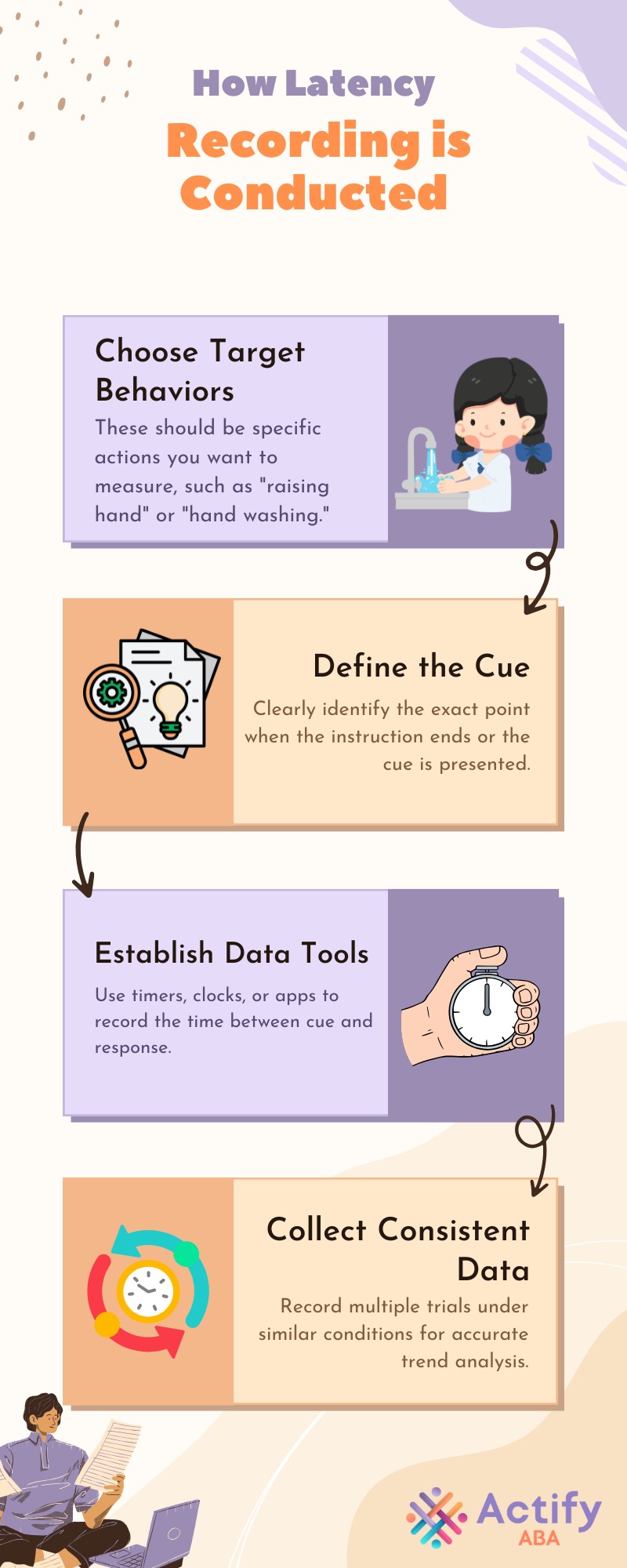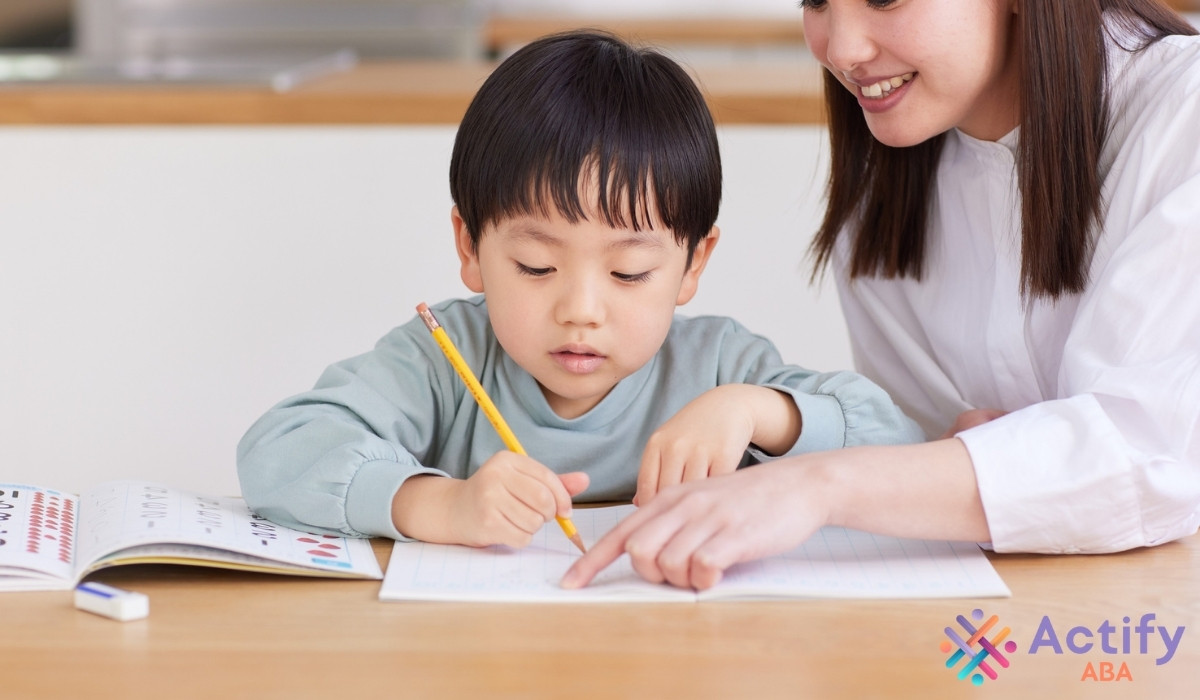
Key Points:
- Latency recording in ABA measures the time delay between an instruction and the child’s response.
- It’s crucial for identifying delays in skill acquisition, attention, and motivation.
- Accurate latency tracking supports refined instruction and effective behavior plans.
Latency recording is a valuable tool in ABA therapy that measures the time between a given instruction and the child’s response. This type of data is especially useful for evaluating attention, processing speed, and the child’s readiness to engage in tasks.
Unlike frequency or duration recording, latency data highlights hesitation and delays that might otherwise go unnoticed. It offers insight into whether the child fully understands the instruction, needs additional support, or is struggling with motivation.
For therapists and parents, using latency recording means being able to fine-tune interventions—not just by what is done, but by when it’s done—leading to more responsive and effective ABA programming.
What is Latency Recording in ABA?
Latency recording in ABA is the measurement of the time elapsed between a cue or instruction and the start of the child’s response. For example, if a therapist says “touch your nose” and the child touches it after 3.5 seconds, the latency is 3.5 seconds.
Latency data helps identify whether delays are due to a lack of skill, confusion, or motivation. It’s especially useful when a child eventually responds correctly but slowly, highlighting areas for reinforcement and targeted support.
When Should You Use Latency Recording?
Tracking latency allows behavior analysts to adjust prompts, reinforce quicker responses, and monitor progress over time. Integrating latency tracking into behavior plans depends on what you’re trying to achieve. This method is valuable in several contexts:
1. Skill Acquisition
When learning new behaviors, fast and accurate responding indicates fluency. Measuring latency helps detect whether the child is becoming automatic or still struggling.
2. Attention and Prompting
Latency shows if a child is attending to the instructional cue or only responding after repeated prompts.
3. Motivation and Reinforcement
Slower responses might mean the child isn’t motivated by the reinforcer or is hesitant due to uncertainty.
By measuring latency across diverse tasks, ABA teams can tailor prompting strategies, adjust reinforcement, or modify instructions to improve fluency and reduce delays.
How is Latency Recording Conducted?
Latency recording requires careful preparation to ensure accurate and meaningful data. It begins with identifying the specific behavior to track, defining when the instruction starts and ends, and using reliable tools for timing. This process helps uncover patterns in how quickly a child responds across different situations.
Here’s how latency recording is conducted:

Consistency is key. Without clear definitions and data collection, latency measures can be misleading. Once data is gathered, behavior analysts can see patterns and adapt interventions accordingly.
Why is Latency Measurement Important?
Latency measurement is important in ABA because it reveals how quickly a child responds after receiving an instruction, offering insight into attention, comprehension, and motivation. It helps identify delays even when responses are correct, ensuring interventions address both accuracy and fluency.
Without this data, a child’s hesitation or processing difficulty might go unnoticed, potentially slowing learning. Latency recording ensures behavior plans are precise, responsive, and tailored to the child’s needs.
What are Examples of Latency Recording?
Latency recording can be applied in various real-world situations to track how quickly a child responds after a prompt. By measuring delays across settings like classrooms, home routines, and social situations, behavior analysts can better understand learning patterns and tailor interventions to improve the speed and fluency of response.
Below are some examples of latency recording:
1. Classroom Commands
A teacher says, “Line up,” and records how many seconds children take to get in line. Faster latencies over time reflect better stimulus control.
2. Self-Care Routines
When prompting “brush your teeth,” parents can track how long it takes before the child begins. Reducing that delay shows progress toward independence.
3. Social Engagements
In peer interactions, measuring how long it takes to greet or respond to a question reveals social processing and engagement delays.
These hands-on applications demonstrate how latency recording provides invaluable insight into skills hidden beneath simple accuracy.

How Do You Interpret Latency Data?
Interpreting latency data helps behavior analysts and caregivers understand how quickly a child responds to instructions over time. When latency decreases steadily, it typically signals progress in attention, processing, or motivation.
Consistent, short response times suggest that the child is becoming more fluent and confident with the task at hand. On the other hand, long or inconsistent latencies can indicate confusion, lack of engagement, or the need for clearer prompts or reinforcement.
It’s also important to consider patterns and context. A sudden increase in latency might reflect environmental distractions, emotional discomfort, or task difficulty. Analysts look for trends, variability, and plateaus to decide whether interventions are working or need to be modified.
What are the Best Practices for Latency Recording?
To ensure that latency data is meaningful and actionable, it must be collected with precision and consistency. This means everyone involved in data collection should follow clearly defined procedures, use the same tools, and document contextual details.
Even small variations in timing or cue delivery can skew results, so establishing reliable protocols is critical. Below are key best practices that improve accuracy and strengthen the value of latency tracking in ABA therapy:
1. Be Precise
Start the timer immediately after the instruction ends and stop it as soon as the child begins the target behavior. Accurate timing ensures reliable data that truly reflects the child’s response time.
2. Use Reliable Tools
Digital timers, stopwatch apps, or ABA-specific data platforms offer precision and consistency. These tools reduce the risk of human error and improve the efficiency of latency measurement.
3. Train Observers
Make sure all team members—including parents, therapists, and educators—are trained to use the same timing and recording procedures. Consistency across observers strengthens the reliability of your data.
4. Log Contextual Notes
Always note factors like noise, fatigue, or mood that might influence latency. These observations provide valuable context and help explain fluctuations or outliers in response times.
5. Maintain a Data Diary
Include annotations alongside latency times to track trends and patterns over time. These qualitative notes add depth to the numbers and guide better clinical decision-making.
When is Latency Recording Not Enough?
Latency recording is useful for tracking how quickly a child responds to a prompt, but it doesn’t capture the full picture of behavior. It doesn’t show how long the behavior lasts, how often it occurs, or whether it happens consistently across time and settings.
To get a comprehensive view of a child’s progress, behavior analysts often combine latency data with other methods like duration, frequency, or interval recording. This multi-measure approach ensures that therapy targets not just quick responses, but sustained, functional, and meaningful behavior change.
Support Your Child’s Growth With ABA Therapy
Latency recording may seem technical, but it’s a powerful tool to understand how skills are being performed, not just whether. By tracking response times, behavior analysts and families can fine-tune strategies, build fluency, and support meaningful independence.
At Actify, we specialize in ABA therapy in Maryland, using precise tools like latency tracking to guide personalized plans. Our team works closely with families to translate data into practical interventions that drive real-life results.
Reach out to us to learn how ABA therapy in Maryland with latency monitoring can help your child build confidence and competence—one timely response at a time.
